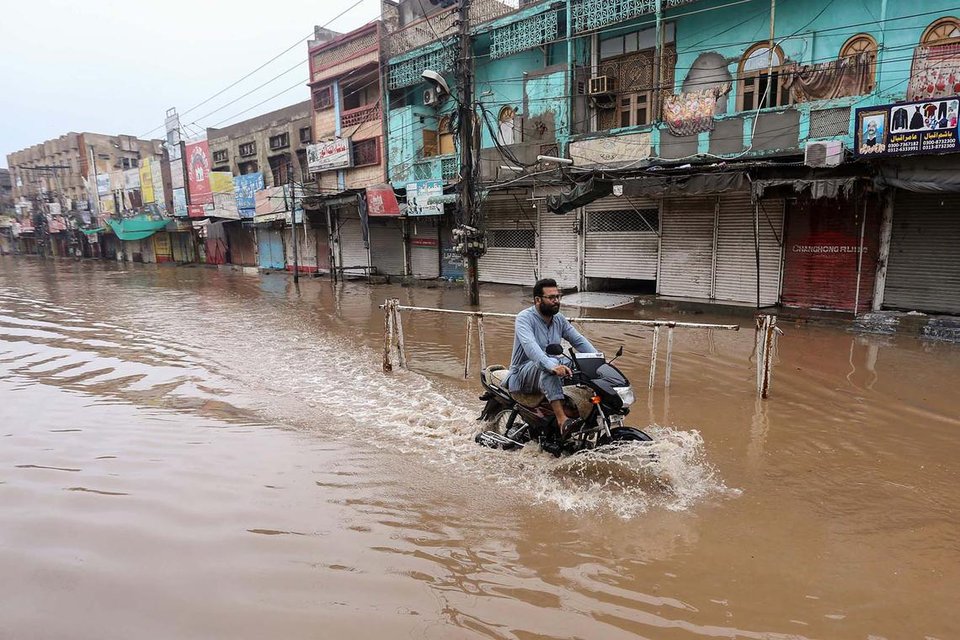By Staff Reporter
ISLAMABAD: At least 31 people have been killed and dozens more injured across Pakistan’s northwestern Khyber Pakhtunkhwa (KP) and Punjab provinces in the past 48 hours as heavy rains triggered flash floods, landslides, and structural collapses, provincial disaster authorities reported.
The relentless downpours, which began June 25, have also disrupted railway operations in southern Sindh and raised fears of urban flooding in Karachi and other cities, with forecasters warning the worst may not be over until at least Tuesday.
In Khyber Pakhtunkhwa, the Provincial Disaster Management Authority (PDMA) reported 19 deaths and six injuries, with the district of Swat suffering the heaviest toll: 13 people killed and six injured. “In the past 48 hours, rain, strong winds, flash floods and landslides in Khyber Pakhtunkhwa province have resulted in the deaths of 19 people and injuries to 6 others,” the PDMA said in a statement. “The most affected district was Swat, where 13 people died and six others were injured.”
The casualties included six men, five women, and eight children, underscoring the indiscriminate impact of the deluge. Across the province, 56 homes were damaged, 50 partially and six completely, in districts such as Swat, Abbottabad, Charsadda, Malakand, Shangla, Lower Dir, and Torghar.
Punjab, Pakistan’s most populous province, reported an additional 12 deaths and 39 injuries. “Twelve people died and 39 were injured in various accidents,” the Punjab PDMA said in a statement. “Majority of deaths were caused by the collapse of roofs and walls.”
The agency’s chief, Irfan Ali Kathia, called on residents to avoid unnecessary travel and steer clear of unstable buildings, a plea echoed by authorities nationwide as the rains show no sign of letting up.
The Pakistan Meteorological Department has warned that heavy rains and potential flash floods could persist until at least Tuesday, a forecast that has put the country on edge.
In southern Sindh, the National Disaster Management Authority (NDMA) issued an alert on Saturday highlighting the risk of urban flooding in districts including Sujawal, Thatta, Badin, Karachi, Hyderabad, and Mirpurkhas within the next 48 hours.
Karachi, a sprawling port city of over 22 million, has been battered by moderate to heavy rainfall since Thursday night, claiming two lives, according to police, hospital, and rescue officials. The rains have also snarled transportation.
Babar Raza, a spokesperson for Pakistan Railways, told media that the weather had disrupted the railway signaling system, forcing trains to slow down for safety. “As a result, some trains are reaching their destinations with a delay of three to four hours,” he said. “No trains have been canceled so far.”
Pakistan, with a population exceeding 240 million, is no stranger to extreme weather, a vulnerability amplified by its status as one of the world’s most climate-change-threatened nations. Last month alone, severe storms killed at least 24 people nationwide, following a year marked by hailstorms and unseasonal spring downpours.
The current monsoon, which typically soaks the region from June to September, has brought both relief from scorching heat and deadly consequences.
In Sindh, the Meteorological Department reported that “strong monsoon currents” are driving thunderstorms and moderate to heavy rainfall across Karachi and districts like Jamshoro, Dadu, Badin, Thatta, Sujawal, Hyderabad, Mitiari, Sanghar, Tando Allahyar, Tando Muhammad Khan, Shaheed Benazirabad, and Nosheroferoz.
For Sunday, Karachi faces intermittent rain with moderate to isolated heavy falls, with temperatures between 30-32 degrees Celsius and humidity at 75-85 percent. Monday promises cloudy skies with possible light rain or drizzle, temperatures climbing to 32-34 degrees Celsius.
Other parts of Sindh, including Tharparker, Umerkot, Mirpurkhas, Sukkur, Larkana, Kamber Shahdadkot, Shikarpur, Khairpur, Jacobabad, Ghotki, and Kashmore, will see rain and thunderstorms with moderate falls through Sunday, with occasional breaks.
The Met Office cautioned that “heavy downpour/windstorm and lightning may affect daily routines, urban flooding, water logging in low lying areas and may damage weak structures like roof/wall of Kacha houses, electric poles, billboards, vehicles and solar panels, etc. during the forecast period.”
Copyright © 2021 Independent Pakistan | All rights reserved




